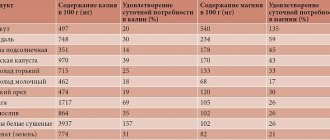Calcium is one of the key macroelements of the body, which is involved in a large number of vital functions. More than 99% of calcium is found in bones and teeth; the remaining free calcium circulates in the blood supply and body tissues.
Products containing calcium must be present in a person’s daily diet to ensure the normal functioning and development of the body.
Introduction
In the second half of our century, significant discoveries were made in the field of mineral metabolism and its endocrine regulation. The new knowledge gained about the regulation and disorders of calcium metabolism has made it possible to understand the pathogenesis of various clinical syndromes caused by these disorders. Such syndromes include rickets, osteochondrosis, osteoporosis, especially postmenopausal with a high risk of vertebral fractures, visceral and skeletal forms of hyperparathyroidism, osteodystrophy, urolithiasis, atherosclerosis, Fahr's disease with calcium deposition in the brain, calcification, dermatomyositis and others.
Calcium is a phosphatophil by nature and is found in various tissues, in particular in the mitochondria of cells in the form of phosphate salts (calcium hydroxyapatite). If apatites are the most sparingly soluble calcium salts, then compounds with inorganic bisphosphates (pyrophosphates) can become insoluble (in bones) or soluble (in soft tissues), depending on the conditions, i.e. inorganic bisphosphates are natural regulators of calcium metabolism in the body. With a gradual decrease in the activity of numerous regulatory mechanisms with age, calcium metabolism is disrupted and insoluble calcium salts are deposited in soft tissues. The question arises, is skin an exception? To answer this question, a study was conducted on changes in calcium content in the cells of various layers of the skin depending on age.
Constant update
Many people believe that the human skeleton is a “stone” skeleton that gradually increases its mass as it grows older and undergoes virtually no changes. This is not entirely true. The skeleton, like any other organ, is in constant renewal. Resorption and removal of old, damaged areas of bones and the formation of new young structures occur. In childhood, this process is very intense, and the skeletal system is completely renewed in 1–2 years. The daily amount of calcium intake directly affects the rate of linear growth and bone mineral density, determining the physical development of the child and even the long-term risks of bone fractures in old age.
The role of calcium in the body and its natural regulation
The biological functions of calcium are extremely complex and diverse. Calcium plays a structural role, forming, together with phosphorus, the mineral basis of the skeleton - hydroxyapatite crystals. The skeleton contains 99% of all calcium and 85% of all phosphorus contained in the body. We can say that due to the significant reserves of calcium in the skeleton, it belongs to the macroelements, but at the level of the cytoplasm, where calcium is involved in regulatory processes, its concentration does not exceed 10-7 M, which makes it possible to classify it as a microelement.
The special role of calcium is the regulation of intracellular processes, the development of which is determined by changes in the intracellular calcium concentration:
- motor activity of cells (muscle contraction, chemotaxis, etc.);
- excitability of cells capable of generating an electrical action potential (muscle tone, heartbeat, etc.);
- secretion of hormones and neurotransmitters;
- phagocytosis, pinocytosis;
- cell reproduction (mitoses, etc.).
The system of intracellular regulation and “threshold action” of calcium is able to function only if the cell has effective mechanisms for maintaining a low concentration of calcium inside the cell and a huge electrochemical gradient in the plasma membranes. Maintaining a low calcium concentration inside the cell (10-7 M) in an environment with a relatively high calcium concentration (10-2 -10-3 M) is ensured by special biochemical mechanisms:
- the ability of the cytoplasmic membrane to resist the penetration of calcium ions into the cytoplasm;
- the presence in the membrane of a special Ca++ATPase, which actively pumps calcium ions out of the cell using ATP energy;
- the action of exchange transport in the membrane (removal of calcium ions from the cell in exchange for sodium entering the cell);
- high calcium-binding ability of a number of intracellular organelles (mitochondria), as well as specific calcium-binding proteins, which play the role of a buffer providing a low concentration of free calcium ions even in the case of an increased calcium flow into the cell (calmodulin - vitamin D, Ca-binding protein , troponin C and others)1.
Intracellular calcium homeostasis is closely related to its extracellular levels, which are also carefully controlled in the body. Plasma calcium concentration averages 2.5 mM. Approximately 40% of this amount is bound to proteins and 10% is bound to other ions, so that only about half of serum calcium is normally present in the form of ionized calcium, the concentration of which is carefully controlled not only inside the cell, but also in the extracellular environment. The constancy of the concentration of ionized calcium is explained by its important role in many biological processes, mainly in three target organs: the small intestine, bones, and kidneys. In bones, the processes of bone resorption and remodeling (osteoclasts)2 depend on the level of ionized calcium. The movement of calcium is controlled by three hormones: parathyroid hormone (PTH), the hormonal form of vitamin D-1,25(OH)2D3 - calcitriol and calcitonin, produced by the thyroid gland. All three hormones directly regulate blood calcium concentrations through a feedback mechanism. Of all three hormones, the most important role is played by parathyroid hormone, which increases the level of calcium in the blood, acting on all three target organs. Vitamin D metabolites are also involved in the regulation of bone mineralization. Calcitonin – suppresses bone destruction. This ability is used in the treatment of diseases with increased bone resorption - such? such as Paget's disease, osteoporosis and others. The hormone is secreted in response to high calcium concentrations in the blood (positive feedback).
Pathologies of calcium metabolism
Pathogenetic mechanisms of calcium metabolism disorders can be divided into two groups: endocrine and energy-dependent. The first group includes conditions caused by dysfunction of the parathyroid glands, which play a role in regulating the level of calcium in the extracellular fluid. For parathyroid hormone, the target organs are bone tissue and kidneys. The second most important regulator of calcium metabolism is the thyroid hormone calcitonin, which maintains intracellular calcium homeostasis3. But estrogen and vitamin D are most directly involved in the metabolism of calcium in skin cells. With a decrease in the production of estrogen in women after menopause, the skin quickly ages and serious problems arise with calcium metabolism in the bones. On the other hand, limiting skin exposure to UV rays with age reduces the accumulation of vitamin D in the skin, which is formed through photobiogenesis that occurs in the skin under the influence of UV rays. Vitamin D also ensures skin resistance to UV rays. The hormonal form of vitamin D - 1.25 dihydroxycholecalciferol (calcitriol) stimulates the absorption of calcium and phosphates in the intestines and their reabsorption in the kidneys, stimulates bone remodeling, calcium transport through cell membranes, cell differentiation, and the development of the immune system. In addition to the hormones that regulate calcium metabolism (group I factors), the second group of factors produced in cells as a result of ATP transformation is of great importance in its regulation. This group of factors includes inorganic poly- and bisphosphates, which are products of normal energy metabolism in cells. With age, ATP production decreases significantly and, as a result, the formation of poly- and bisphosphates decreases, which leads to disturbances in calcium metabolism4.
Breast-feeding
Mother's milk is the main food product for children in the first year of life. Its composition ideally matches the child's needs and changes dynamically as the baby grows and develops. Breast milk is the main source of minerals in the first half of a baby’s life. The total amount of calcium in human milk is lower than in cow's milk. But thanks to the ideal ratio between phosphorus and calcium, as well as the presence of special proteins that facilitate the transport of minerals through the intestinal wall, their absorption is very high. At this age of the baby, it is very important that the mother’s diet is balanced and rational so that the child receives sufficient necessary substances and maintains the mother’s health. In addition to the daily presence of dairy products in the menu, nursing mothers are recommended to take additional calcium as part of vitamin and mineral complexes. When artificial feeding, it is necessary to give preference to adapted formulas containing lactose for better absorption of calcium and vitamin D.
Pathological skin conditions caused by the deposition of calcium salts
In order to study the nature of the accumulation of calcium salts (mainly phosphates) in the skin depending on age, we examined histological samples of the skin of the anterior thigh in 8 people of different ages: 4 years, 9 years, 12 years, 30 years, 50 years, 60 years , 65 years old, 70 years old. In children, skin samples were taken incidentally during diagnostic skeletal muscle biopsy. The choice of place for skin biopsy is due to the virtual absence of exposure to the external environment (UV rays, chapping) and cosmetics. To assess the nature of the accumulation of calcium salts in the skin, the Kossa histochemical staining method was used. The biopsy material was fixed in strong alcohol, followed by the preparation of sections from paraffin blocks. Sections were stained with 5% silver nitrate for 60 minutes in the light, followed by treatment with a 5% hyposulfite solution, washing and embedding in paraffin. Analysis of the deposits of calcium salts, colored black, was carried out using a light microscope. The intensity and prevalence of calcium salt deposition in skin cells was assessed (Fig. 1, 2, 3).
Fig.1. Skin of a 12 year old child. Microconglomerates of calcium salts are detected in small quantities, mainly in the area of the basal (germinal) layer of the epidermis. Coloring according to Kossa, uv. 40x.
Fig.2. Skin of a 50 year old woman. A significant amount of microconglomerates of calcium salts is detected in the area of the basal (germ) layer of the epidermis. Coloring according to Kossa, uv. 40x.
Fig.3. Skin of a 70 year old woman. A sharp increase in microconglomerates of calcium salts in the area of the basal (germ) layer of the epidermis is detected. Coloring according to Kossa, uv. 40x.
The results of the analysis showed that the skin of children was characterized by a small amount of microconglomerates of calcium salts. Histological preparations were characterized by the presence of a small amount of diffuse dust-like inclusions, mainly in the basal layer of the epidermis. In older people, both the number and size of microconglomerates of calcium salts in the skin increased. The greatest degree of their accumulation was noted in the basal layer of the epidermis of 65- and 70-year-old people. In addition to accumulation in the basal layer, coarse microconglomerates of calcium salts were detected in the connective tissues of the papillary and reticular layers of the skin. In Fig. Figure 4 shows an increase in the number of calcium deposits in the skin, taking into account the nature of their deposits in the cell. In Fig. Figure 5 shows the total assessment in points of the intensity of filling human skin cells with calcium salts depending on age. When calculating the scores, the proportion and degree of filling of the germ zone cells with calcium deposits was taken into account.
Rice. 4. Changes in the nature and type of deposition of calcium salts in skin cells with age in humans.
Rice. 5. Increase in the amount of insoluble calcium salts with age (estimated in points).
Thus, it has been morphologically shown that with age, the degree of accumulation of calcium salts in the skin of people increases, maximum calcium deposits are found in elderly people, and the deposition of calcium salts mainly in the cells of the germinal layer of the epidermis contributes to the aging process of the skin, which intensifies with age.
Daily norm
The daily need for calcium directly depends on the age and gender of a person. Moreover, the largest amount of macronutrients is required by a growing body, pregnant and lactating women.
The daily value of calcium is:
- for newborns up to 6 months – 400 milligrams;
- for preschool children (1 – 5 years) – 600 milligrams;
- for schoolchildren under 10 years old – 800 milligrams;
- for children from 10 to 13 years old – 1000 milligrams;
- for teenagers and young people under 24 years old – 1300 – 1500 milligrams;
- for women (from 25 to 55 years) and men (from 25 to 65 years) – 1000 milligrams;
- for women during menopause (from 55 to 85 years old) and older men (from 65 to 85 years old) – 1300 – 1500 milligrams;
- for pregnant and lactating women – 1500 – 2000 milligrams.
The need for calcium increases with:
- intense sports activities;
- profuse sweating;
- taking anabolic steroids;
- hormonal therapy.
Remember, it is important to monitor the amount of calcium consumed daily, since a lack of the mineral can lead to osteoporosis of the bones, and an excess can lead to stone formation in the kidneys and bladder.
Methods for artificial regulation of calcium metabolism in skin cells
The presented data substantiated the feasibility of including compounds in cosmetic creams that regulate calcium metabolism in skin cells as an additional means for preventing skin aging. The best effect among various chelating compounds capable of forming highly stable compounds with calcium was found when using bisphosphonates in the form of sodium-potassium salt5,6.
This compound is a synthetic analogue of inorganic bisphosphate, the advantages of which, compared to the natural regulator of cellular calcium metabolism, are its resistance to spontaneous and enzymatic hydrolysis. There are no enzymes in the human body that destroy this bisphosphonate, which makes it possible to obtain a regulatory effect on calcium metabolism when using small doses of the drug. When studying the pharmacokinetics of the drug administered through the skin, it was shown that it is absorbed through intact skin much better than from the gastrointestinal tract (3-5% compared to 0.5-1.0%, respectively). In addition, it was revealed that the drug enters the blood and is excreted in the urine within 36-48 hours. Maintaining the therapeutic concentration of the drug for 24-36 hours with transdermal administration provides a prolonged therapeutic effect, in contrast to the oral route of administration, in which a peak concentration in the blood is created within 3-5 hours, and by 10-12 hours after After a single dose, the drug is practically absent in the blood (urine)7.
We confirmed the calcium-regulating effect of bisphosphonate on the skin in an auto-experiment on skin biopsies of 2 women (40 and 60 years old), in whom a cream containing 0.5% of the drug was applied to the skin of the thigh on one side - once a day for 10 days. As a control, the skin of the thigh of the other leg was examined. The result shows that there are calcium deposits in the skin without the use of cream. In one case - in all cells in the form of single deposits in the apical region of the cells of the germ zone (40 years), which is equal to 1 point, and in the other (60 years) - 80% of the cells have deposits of calcium salts in the form of single deposits in the apical part of the germ zone zones and 40% of cells - in the form of circular deposits, which is equal to 2.4 points. In the skin of the thigh of both women after applying the cream, no deposits of calcium salts were found in the cells of the growth zone (Fig. 6a and 6b). The absence of deposits of calcium salts after treatment in the cells of the epidermal growth zones confirms the positive effect of the drug as a preventive agent for calcification of cells of the germ layer of the skin. When biopsy sections were stained with xydiphon (1% cobalt sulfate in an alkaline medium), it was shown that the drug accumulates precisely in the cells of the germinal (basal) layer of the epidermis, which most often undergo calcification.
Fig. 6. Skin of a 40-year-old woman before (a) and after (b) application of REFARM cream (Cossa stain for calcium, magnification 40x).
Thus, with age, the skin loses its ability to regenerate and, as a result, elasticity, not only as a result of changes in its organic components, but also, obviously, due to the increasing accumulation of insoluble calcium salts in the cells of the germ layer.
Study of the clinical effectiveness of cosmetic creams containing xidifon
The use of creams containing bisphosphonate has a therapeutic and preventive effect, preventing calcium deposits in skin cells, which, in combination with the preventive effect of the nourishing base of the cream, suggests an increase in the anti-aging effect of cosmetics. In this regard, this part of the work is devoted to an experimental and clinical study of the biological activity of creams produced by the REPHARM Institute of Pharmaceutical Reagents. In the experiment, the following was carried out:
- Histological examination of skin biopsies of white rats after 30 applications.
- Studying the effect of creams on the state of the protective function of the skin of laboratory animals using the method of determining the time of alkali neutralization according to the Burghart method.
- Clinical assessment of the state of functional indicators of the skin under the influence of the presented creams included:
- Study of the moisture-holding capacity of the skin;
- Study of the state of lipid metabolism of the skin;
- Study of skin elasticity;
- Study of skin profile (width and depth of wrinkles).
The following results were obtained:
- A histological study of animal skin preparations treated with REPHARM creams revealed their effect on water-electrolyte and protein metabolism in the skin, manifested in an increase in the hydration properties of the skin.
- A study of the effect of creams on the state of the protective function of the skin showed that in group 1 of animals, i.e. in rats that received the cream, restoration of the initial time of neutralization of alkali by the skin (6 minutes) occurred after 2 days. After 3 days, this indicator decreased and amounted to 4 minutes, i.e. a prolonging effect of the drug was noted. In group 2 of animals, i.e. in rats on whose skin the cream was not applied, restoration of the initial time of alkali neutralization occurred only on the 7th day after cessation of exposure to alkali, i.e. almost 2.5 times slower than in rats of group 2. Thus, the results obtained indicated a pronounced positive effect of the cream on the condition of one of the main functions of the skin - protective.
- The clinical trials involved 20 volunteers - clinically healthy women without a significant allergic history, aged 35 to 50 years. 11 patients were diagnosed with combination facial skin, 9 with dry skin complicated by hyperkeratosis. Clinically, this manifested itself in dry skin and the presence of a network of fine wrinkles. The cream was applied to previously cleansed skin of the face and body every day, 2 times a day for 3 weeks.
The study of the effect of creams on the moisture-holding capacity of the skin was carried out using the Moisture Meter device, Russia. 20 minutes after the first application of the cream, the moisture content in the skin increased by an average of 67.3% compared to the initial level, after 2 hours this figure was 51.5%, after 4 hours - 36.6%, after a course of use by 15 .6%.
The data obtained indicated a positive effect of the cream on water-electrolyte metabolism in the skin and a pronounced hydration effect of the drug.
When studying the effect of creams on the elastic properties of the skin, it was found that the stretching indicator as a result of a course of cream use increased by an average of 10.9% compared to the initial one.
When studying the skin profile (width and depth of wrinkles) using the Tester T-2000 device, it was found that as a result of 3 weeks of use of the cream, there was a decrease in the Rt tooth by 5.09%, Rmax by 6.7%, Rz-d by 6.3% compared to the initial level, i.e. a positive effect of the cream on indicators characterizing the skin profile was stated.
Based on the analysis of the formulation and the results of the research, we can conclude that REFARM cosmetic creams, which include a calcium metabolism regulator, are effective cosmetics, the use of which has a pronounced hydrating effect, improves the elasticity and tone of the skin, smoothes out a network of fine wrinkles, improves the protective function of the skin.
These cosmetics can be recommended for use in broad cosmetology practice to care for the body's skin as an effective means of preventing and correcting skin aging processes.
Literature
- VC. Bauman, “Biochemistry and physiology of vitamin D” Riga, Zinatye, 1989, 480 p.
- Fleisch, Bisphosphonates in bone disease, 1997, London, 184p.
- Feldman, D., and Mallon, P. J. and Gross, C. (1996). Vitamin D: metabolism and action.In Marcus, R., Feldman, D. and Kelsey, J. (eds) Osteoporosis, pp.205-35. (San Diego: Academic Press).
- Bushinsky, D. A. and Krieger, N. S. (1992). Integration of calcium metabolism in the adult. In Coe, FL and Favus, MJ (eds.) Disorders of Bone and Mineral Metabolism, pp.417-32. (New York: Raven Press).
- O.G.Arkhipova, E.A. Yuryeva, N.M. Dyatlova, “Prospects for the use of xydiphone”, J. Vses. chem. total them. DI. Mendeleeva, 1984, XXIX, 3, pp. 76-80.
- T.A. Matkovskaya, N.P. Tatarnikova, etc. Pat. RF RU 2124881 C1.
- E.A. Yuryeva, I.P. Dunaeva, G.I. Kulakova “The effectiveness of xydiphone depending on the method of its use”, In: New chelating agent xydiphone. Pharmacology, toxicology and therapy. Moscow, 1990, pp. 62-70.
(The article is abbreviated. The full text was published in the journal: Cosmetics and Medicine, 1999, No. 5/6, p. 71.)
What foods are rich in calcium
To prevent the body from experiencing calcium deficiency, the following foods should be included in the diet every day:
- milk and all products made from it - various cheeses, cottage cheese, kefir and yoghurts, cream and sour cream;
- seafood - mussels, oysters, sardines, salmon, kelp (sea kale);
- raw eggs;
- fresh vegetables - onions, cabbage - preferably cauliflower and broccoli;
- fresh and dried herbs - parsley, watercress, celery, cilantro, spinach;
- fruits - oranges, pineapple, apricots, grapes, currants;
- legumes – beans, peas, soybeans;
- nuts, seeds, sesame, poppy seeds.
Important: it is better to focus on plant sources of calcium, because they contain vitamin D and other biologically active substances that promote the absorption of calcium.







